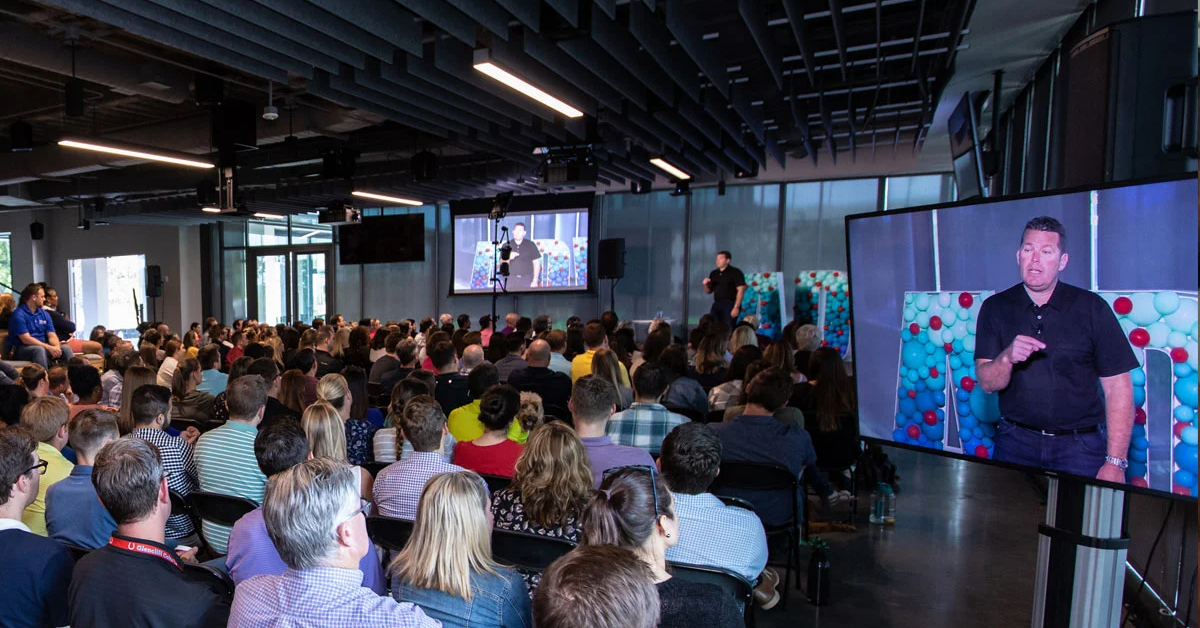If you haven’t read my earlier article about “Killer Keynotes,” allow me to give you the definition of a Killer Keynote: it inspires an audience to take a specific action. It leaves a lasting impression that an audience can remember and reference for their personal and professional use. Most keynotes by average speakers are not “killer keynotes.” They are packed with facts and figures, graphs and scales, paragraphs of words, and montages of pictures. Many speakers routinely overwhelm the audiences with too much information. They have the best of intentions by offering their audiences a plethora of data, but unintentionally lose the battle for their audience’s attention because they lack the Number-One-Single-Most-Important-Positively-Absolutely-Must-Have Ingredient to a Killer Keynote: Telling a Story.
Challenging Speaking Scenarios
Telling a story is challenging, especially during public speaking. The pressure to deliver an engaging speech can cause speakers to rely on slides/notes instead of connecting with the audience through storytelling. Keeping the audience's attention can be daunting, especially when presenting complex information. This can make it even more challenging to tell a story that resonates with the audience.
Engaging Mothers and Sons: Inspiring the Importance of Volunteering
Here’s a speaking situation for you: Imagine you are motivational keynote speaker and you have been given the opportunity to deliver a 45-minute speech to a 200-person audience that is equally split: Mothers and Sons. The Moms in this group are aged between 40 and 55, while their sons range from 13 to 17 years old, corresponding to 8th to 11th graders. There is only one thing on the agenda: You. No other speakers for cover. The speech is in the evening in the middle of the week. You are the only thing reason they have made their kids leave their practices early and postpone their homework. They warn you in advance: “This is a rowdy bunch of boys—they have ants in their pants—it's hard for them to sit still.” Oh, and the event owners want you to drive home the importance of volunteering to their not-so-interested boys.
Uniting a Consumer Services Roll-Up and Inspiring Change
Here’s another speaking scenario for you to imagine: A roll-up consumer services company who has grown dramatically over the past five years through purchasing its smaller competitors across the Southeastern region of the U.S. is struggling to unite the different businesses it has acquired. You work with them for three months in preparation for their first major Sales Kick Off (SKO) involving over 600 audience members. You have been hired to literally kick off the event. Management needs a keynote that will set the tone of inclusivity and encourage the audience to embrace an entirely new profit-sharing system that is based on tracking their individual and team performance. The event owners warn you in advance that their new system has not been well received. Oh, and the night you arrive, the event owner informs you that the CEO you have been working with has just left the company and the COO who is introducing you first wants to tell the audience about his six rules of leadership, (which have nothing to do with what the CEO was originally going to talk about and what you had incorporated into your keynote).
Comparing Scenarios: Moms and Sons vs. Business Challenges
These are just two of many scenarios that I have experienced in just the last six months. Before I go on, which one do you think is a more stressful speaking situation? If you guessed the first one—Moms and Sons—you would be correct. A split audience in gender with a generational age gap is one of the toughest audiences any speaker can face. However, getting any audience to take a pre-determined specific action with enthusiasm is the greatest challenge of all…and personally, I get Fired UP to figure out how to connect with the audience to inspire them to take that action. I literally live for it—I love it.
The Power of Storytelling in Keynotes: Three Key Parts
The reason I share these distinctively different audiences is because the secret to success for each of them comes down to storytelling. There are three key parts to storytelling: selecting the story, telling the story, and then connecting the story to the audience.
1. Selecting the Story
Stories come in all shapes and sizes. Some can be told in ten seconds while others can be used for an entire keynote (and beyond). Killer keynotes are based and built on their stories. You build a Killer Keynote around the stories—not the other way around. Think of stories in lead and supporting roles. Find the lead story first. The story should have a meaningful connection to the audience, allowing them to grasp its message or lessons learned. If you can’t connect it, then don’t use it.
2. Telling the Story
Having a great story is one thing, but how you tell it makes all the difference. To me, telling a story is like jumping out of an airplane: you must go head-first—ALL IN—in telling your story. Bring it to life, give your audience a first-row seat in your story, and make them feel as if they are right there with you. If you’re telling story about SEAL training, make them feel like they are sitting in the water with you. Do you have characters in the story? If so, learn their mannerisms and accents. Practice the art of switching between first, second, and third person. The more senses your story can activate, the more senses you will be able to activate in your audience, which means the more they will remember it. (I have had people come up to me saying “I was getting cold when you were telling the Navy SEAL Surf Torture story!”)
3. Connecting the Story
This is CRITICAL, and it’s what will transform your keynote from a common keynote to one that is a committed-to-memory Killer Keynote: How you connect the story to the audience. Telling an engaging story is great, and it’s an absolute necessity to capture the attention of your audience, but you must help them understand why they should remember what you just told them. It’s easy for them to remember a well-told story, but it’s transformational if they remember why the story is important to them (i.e., inspiring an action).
Neuroscientists suggest that humans have a natural inclination for remembering stories. Mechanisms like emotional engagement, neural coupling, mirror neurons, cognitive ease, contextual and sensory details, social and cultural relevance, and evolutionary advantage all contribute to the effectiveness of storytelling in our memory. These findings highlight the unique ability of our brains to process and recall stories, emphasizing the power of narrative in human cognition.
That’s the good news. Every audience you ever get the opportunity to speak to is pre-programmed to hear a good story. The more you commit to using all your senses—physically, emotionally, mentally, and even sometimes spiritually—the more you will connect with your audience. Just remember, connecting with your audience is only half of the mission. The next half of the mission, should you choose to accept it, is to build upon the connection of your story to a reason why it matters to your audience in such a compelling way that they want to take action after you leave the stage.

